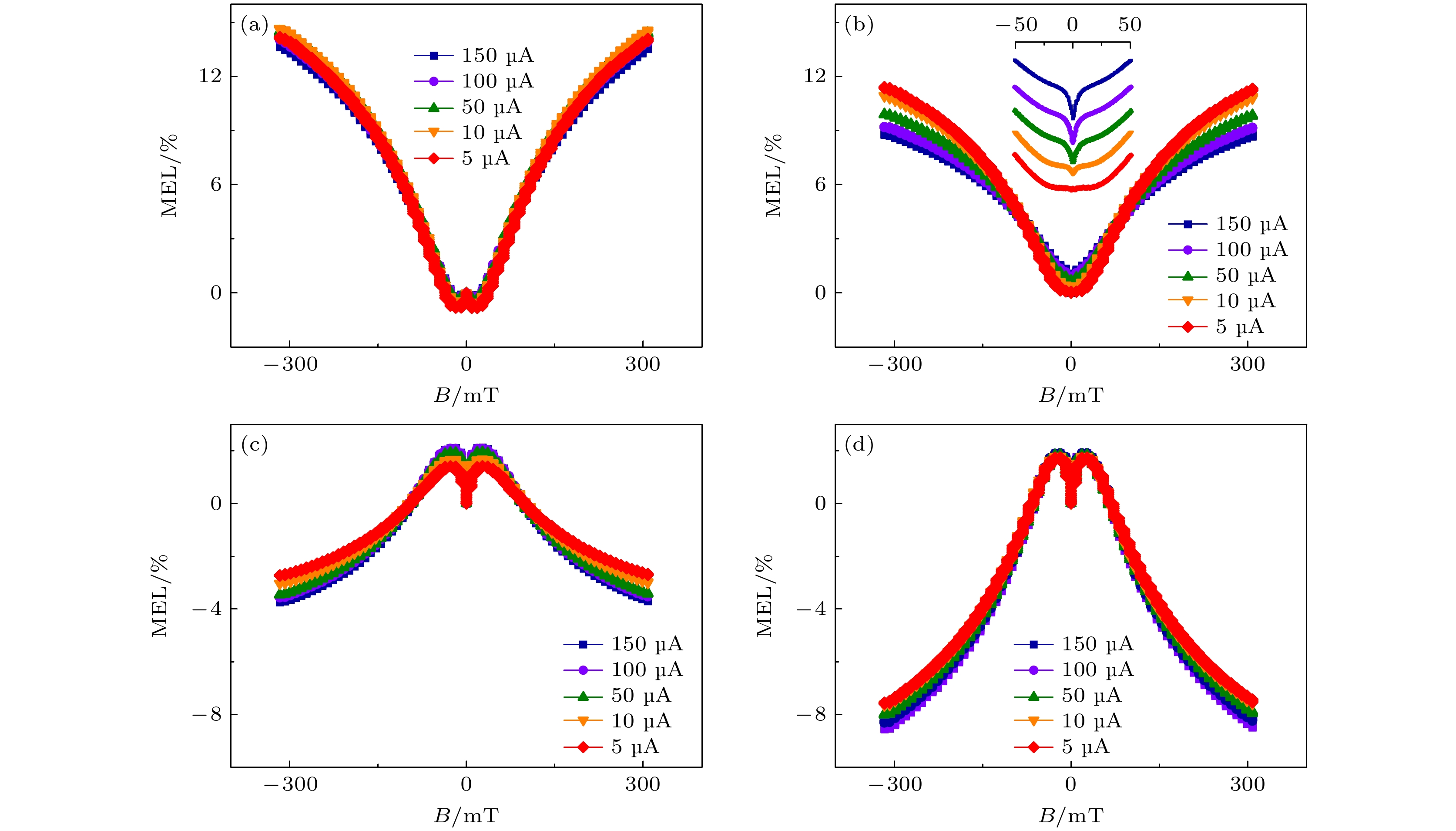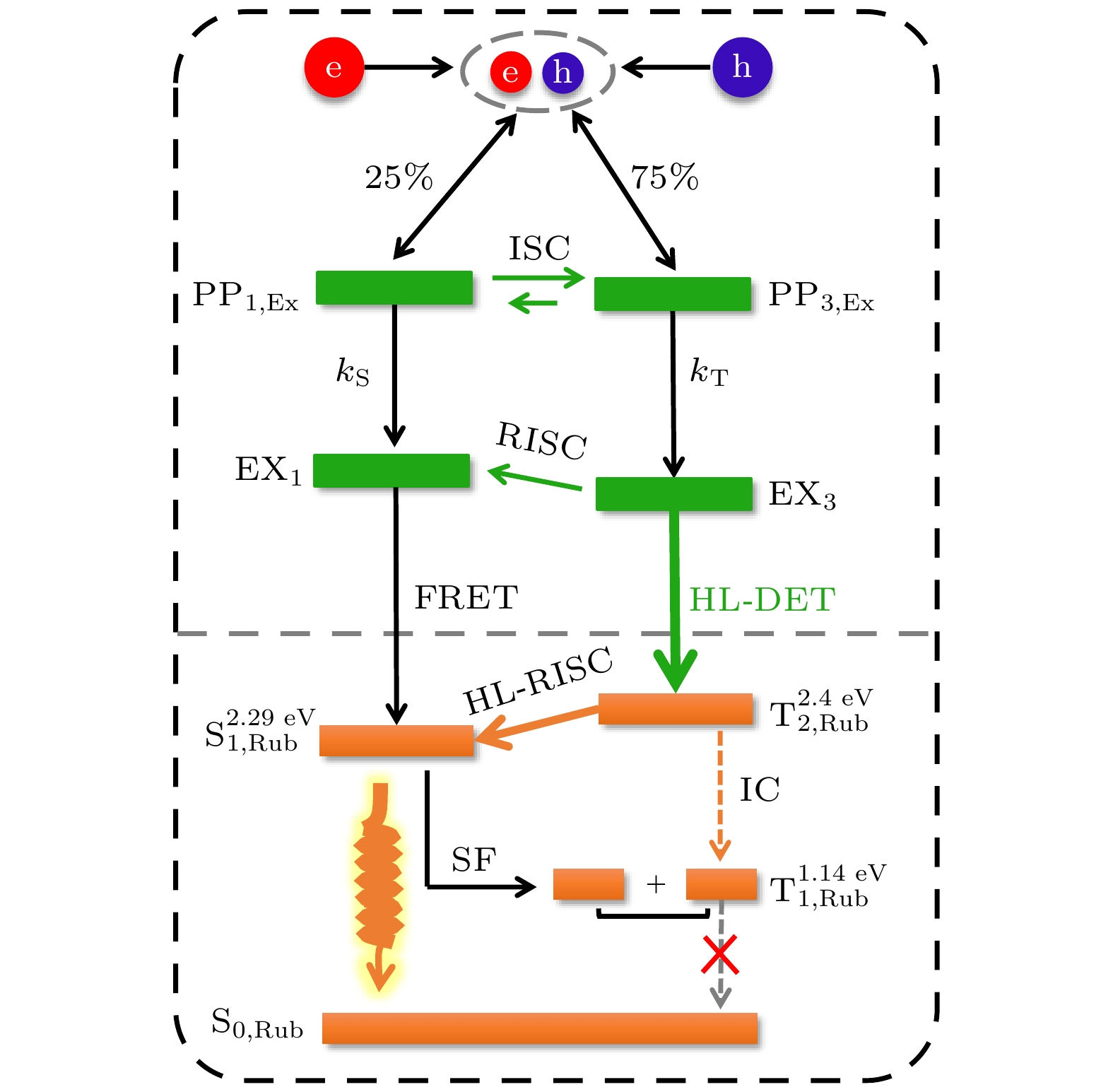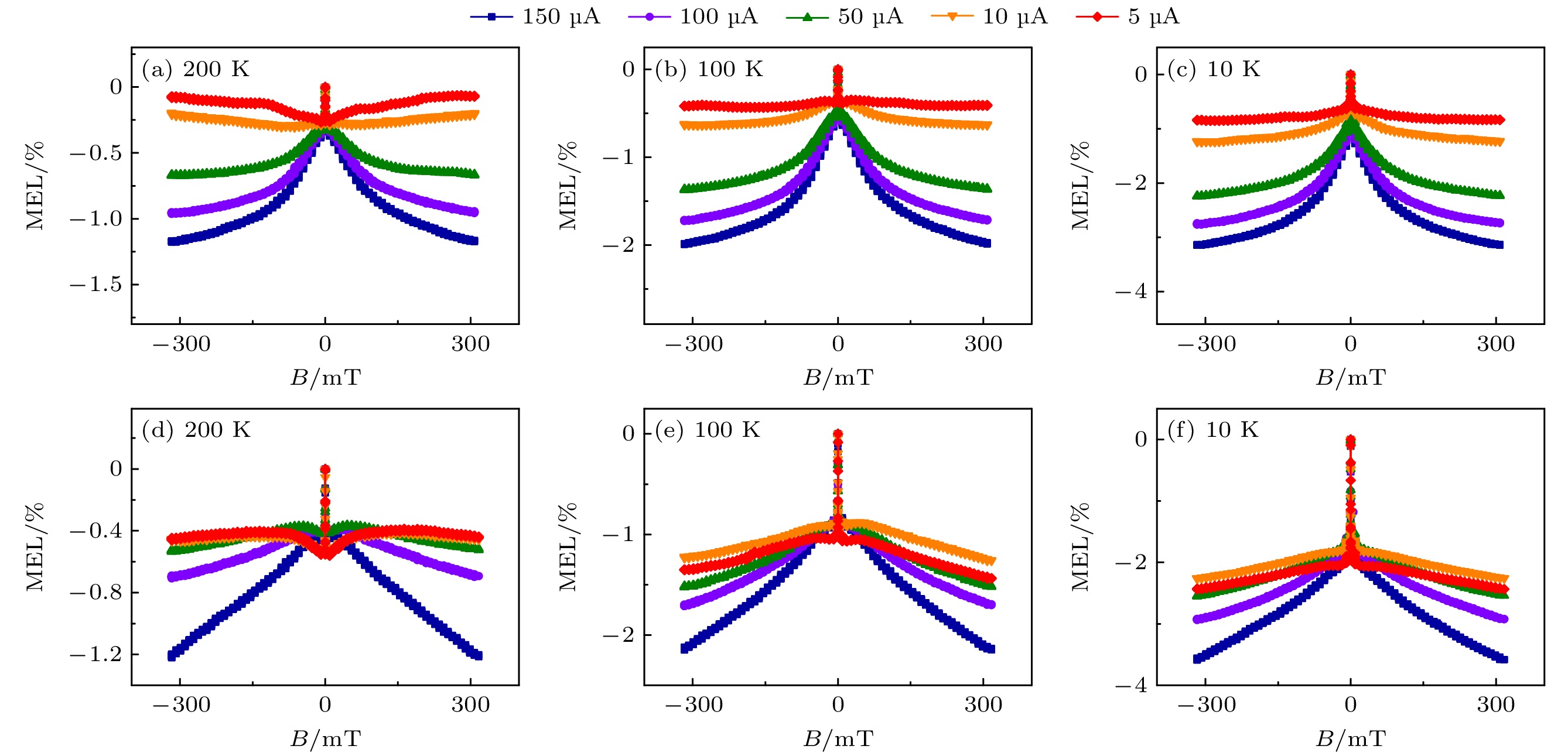-
有机发光二极管 (OLEDs) 中电致发光磁效应(MEL)是一种能够揭示多种激发态微观过程的探测工具. 最新研究成果(Tang X T, Pan R H, Zhao X, Jia W Y, Wang Y, Ma C H 2020 Adv. Funct. Mater. 5 765)表明: 将低浓度的红荧烯(Rubrene)分子掺杂在一定主体作为发光层的OLEDs中, 存在一种高能三重态激子 (T2,Rub)的反向系间窜越过程(HL-RISC, S1, Rub ← T2,Rub). 但本文发现: 以Rubrene作为纯发光层且其两边的载流子传输层也不存在T2,Rub激子的能量损失通道的OLEDs中, 在室温下只观察到单重态激子 (S1)的分裂过程 (S1+S0 → T1+T1), 却没能观察到该T2,Rub激子的HL-RISC过程; 而且, 最基本的因电子和空穴在纯Rubrene发光层中直接注入形成极化子对 (polaron-pair, PP1和PP3)的系间窜越过程 (ISC, PP1 → PP3)也没有被观察到. 为了揭示该反常现象背后的微观物理机制, 以纯Rubrene分子和质量分数为5%的Rubrene掺杂主体作为发光层来制备器件, 并对两种器件的MEL进行变温实验. 对所得实验结果比对分析后发现: 室温下PP态的ISC和T2,Rub激子的HL-RISC产生的MEL正好完全相互抵消, 这是采用MEL在纯Rubrene作为发光层的OLEDs中同时观察不到ISC和HL-RISC的物理原因, 这种如此巧合的物理现象在文献中还未曾报道.With unique advantages of high sensitivity, no-contact, and non-destructiveness, magneto-electroluminescence (MEL) is usually employed as an effective detection tool to visualize the microscopic mechanisms of excited states existing in organic light-emitting diodes (OLEDs) because their evolution channels of many spin-pair states in OLEDs have the fingerprint MEL line-shapes even with opposite signs. The recently-published MEL results (Tang X T, Pan R H, Zhao X, Jia W Y, Wang Y, Ma C H 2020 Adv. Funct. Mater. 5 765) have demonstrated the existence of high-level reverse intersystem crossing process (HL-RISC, S1,Rub ← T2,Rub) of high-lying triplet excitons (T2,Rub) in Rubrene when Rubrene with a typical value of several percent in content is doped into a host with high triplet exciton energy and there are no energy loss channels of triplet excitons from charge-carrier transporting layers either. Furthermore, this HL-RISC process can considerably increase the efficiency and brightness of OLEDs operated at room temperature, for example, high external quantum efficiency up to 16.1% and ten thousands of brightness have been achieved in Rubrene-doped OLEDs with a co-host of exciplex. Herein, surprisingly, in the pure Rubrene-based OLEDs (i.e. the pure Rubrene film is used as an emissive layer) with no energy loss channels of triplet excitons from charge-carrier transporting layers, only strong singlet fission (S1,Rub+S0,Rub → T1,Rub+T1,Rub) processes are detected at room temperature, but this HL-RISC process is not observed. Moreover, even the most usual evolution process of intersystem crossing of polaron-pair (ISC, PP1 → PP3) cannot be observed in this pure Rubrene-based OLEDs, where the polaron-pair is generated through the recombination of the injected electrons and holes in the pure Rubrene emissive layer. To determine the cause of the underlying physical mechanism behind this abnormal and fascinating experimental phenomena, two kinds of devices with pure Rubrene and 5% Rubrene-dopant as emissive layers are fabricated and their current- and temperature- dependent MEL responses are systematically investigated. By comparing and analyzing these tremendously different MEL curves of these two types of devices, we find that the positive Lorentzian MEL curves induced from B-mediated ISC of polaron-pair just completely cancel out the negative Lorentzian MEL curves induced from B-mediated HL-RISC process of T2,Rub excitons. Note that such an abnormal and coincidental experimental phenomenon is the physical reason why the ISC process and HL-RISC process cannot be observed simultaneously in the pure Rubrene-based OLEDs, and this phenomenon has not been found in the literature. Clearly, this work further deepeneds our understanding of some unique microscopic processes and physical phenomena in organic semiconductor “star” material of Rubrene (such as the energy resonance between 2T1 and S1 and the energy approach between T2 and S1).
-
Keywords:
- Rubrene /
- magneto-electroluminescence /
- intersystem crossing /
- high-level reverse intersystem crossing
[1] Lei Y L, Zhang Y, Liu R, Chen P, Song Q L 2009 Org. Electron. 10 889
 Google Scholar
Google Scholar
[2] Liu R, Zhang Y, Lei Y L, Chen P 2009 J. Appl. Phys. 105 093719
 Google Scholar
Google Scholar
[3] Chen P, Peng Q M, Bai J W, Zhang S T, Li F 2014 Adv. Opt. Mater. 2 142
 Google Scholar
Google Scholar
[4] 卢晨蕾, 贾伟尧, 白江文, 张巧明, 令勇洲, 刘洪, 熊祖洪 2015 中国科学: 技术科学 45 396
 Google Scholar
Google Scholar
Lu C L, Jia W Y, Bai J W, Zhang Q M, Ling Y Z, Liu H, Xiong Z H 2015 Sci. Sin.-Tech. 45 396
 Google Scholar
Google Scholar
[5] Liu Y, Wu X M, Zhao Z H, Gao J N, Zhan J, Rui H S, Lin X, Zhang N, Hua Y L, Yin S G 2017 Appl. Surf. Sci. 413 302
 Google Scholar
Google Scholar
[6] Qu F L, Jia W Y, Tang X T, Xu J, Zhao X, Ma C H, Ye S N 2020 J. Phys. Chem. C. 124 9451
 Google Scholar
Google Scholar
[7] Chen Q S, Jia W Y, Chen L X 2016 Sci. Rep. 6 25331
 Google Scholar
Google Scholar
[8] Tang X T, Pan R H, Zhao X, Jia W Y, Wang Y, Ma C H 2020 Adv. Funct. Mater. 5 765
 Google Scholar
Google Scholar
[9] Wang Y, Ning Y R, Wu F G, Chen J, Chen X L, Xiong Z H 2022 Adv. Funct. Mater. 32 2202882
 Google Scholar
Google Scholar
[10] 张勇, 刘亚莉, 焦威, 陈林, 熊祖洪 2012 物理学报 61 117106
 Google Scholar
Google Scholar
Zhang Y, Liu Y L, Jiao W, Chen L, Xiong Z H 2012 Acta Phys. Sin. 61 117106
 Google Scholar
Google Scholar
[11] Tang X T, Zhao X, Tu L Y, Ma C H, Wang Y, Ye S N 2021 J. Mater. Chem. C 9 2775
 Google Scholar
Google Scholar
[12] Tang X T, Pan R H, Zhao X 2020 J. Phys. Chem. Lett. 11 2804
 Google Scholar
Google Scholar
[13] Li J, Chen Z H, Zhang Q M, Xiong Z H, Zhang Y 2015 Org. Electron. 26 213
 Google Scholar
Google Scholar
[14] Xu Y W, Xu P, Hu D H, Ma Y G, 2021 Chem. Soc. Rev. 50 1030
 Google Scholar
Google Scholar
[15] Bai J W, Chen P, Lei Y L, Zhang Y, Zhang Q M 2014 Org. Electron. 15 169
 Google Scholar
Google Scholar
[16] Piland G B, Burdett J J, Kurunthu D, Bardeen C J 2013 J. Phys. Chem. C 117 1224
 Google Scholar
Google Scholar
[17] Chen Y B, Jia W Y, Xiang J, Yuan D, Chen Q S, Chen L X 2016 Org. Electron. 39 207
 Google Scholar
Google Scholar
[18] Zhang Y, Lei Y L, Zhang Q M, Xiong Z H 2014 Org. Electron. 15 577
 Google Scholar
Google Scholar
[19] Desai P, Shakya P, Kreouzis T, Gillin W P 2007 Phys. Rev. B 75 094423
 Google Scholar
Google Scholar
[20] Crooker S A, Liu F L, Kelley M R, Martinez N J, Nie W, Mohite A, Nayyar I H, Tretiak S, Smith D L, Ruden P P 2014 Appl. Phys. Lett. 105 153304
 Google Scholar
Google Scholar
[21] Kawata S, Pu Y J, Saito A, Kurashige Y K, Beppu T, Katagiri H S, Hada, M Kido J J 2016 Adv. Mater. 28 1585
 Google Scholar
Google Scholar
[22] Hu D H, Yao L, Yang B, Ma Y G 2015 Phil. Trans. R. Soc. A 373 20140318
 Google Scholar
Google Scholar
[23] Pan Y Y, Li W J, Zhang S T, Yao L, Gu C, Xu H, Yang B, Ma Y G 2014 Adv. Opt. Mater. 2 510
 Google Scholar
Google Scholar
[24] Kim H B, Kim J J 2020 Phys. Rev. Appl. 13 024006
 Google Scholar
Google Scholar
[25] Obolda A, Peng Q M, He C, Zhang T, Ren J J, Ma H W, Shuai Z G, Li F 2016 Adv. Mater. 28 4740
 Google Scholar
Google Scholar
[26] Tu L Y, Tang X T, Wang Y, Zhao X, Ma C H, Ye S N 2021 Phys. Rev. Appl. 16 064002
 Google Scholar
Google Scholar
[27] Wang F J, Bassler H, Vardeny Z V 2008 Phys. Rev. Lett. 101 236805
 Google Scholar
Google Scholar
[28] 陈秋松, 袁德, 贾伟尧, 陈历相, 邹越, 向杰, 陈颖冰, 张巧明, 熊祖洪 2015 物理学报 64 177801
 Google Scholar
Google Scholar
Chen Q S, Yuan D, Jia W Y, Chen L X, Zou Y, Xiang J, Chen Y B, Zhang Q M, Xiong Z H 2015 Acta Phys. Sin. 64 177801
 Google Scholar
Google Scholar
[29] Peng Q M, Li W J, Zhang S T, Chen P, Li F, Ma Y G 2013 Adv. Opt. Mater. 1 362
 Google Scholar
Google Scholar
[30] Peng Q M, Li A M, Fan Y X, Chen P, Li F 2014 J. Phys. Chem. C 2 6264
 Google Scholar
Google Scholar
[31] Huh D H, Kim G W, Kim G H, Kulshreshtha C, Kwon J H 2013 Synth. Net. 180 79
 Google Scholar
Google Scholar
[32] Zhao X, Tang X T, Zhu H Q, Ma C H, Wang Y, Ye S N, Tu L Y, Xiong Z H 2021 ACS Appl. Electron. Mater. 3 3034
 Google Scholar
Google Scholar
[33] Wu I W, Wang W H, Tseng W H, Chang J H, Wu C I 2012 Org. Electron. 13 13
 Google Scholar
Google Scholar
[34] 宁亚茹, 赵茜, 汤仙童, 陈敬, 吴凤娇, 贾伟尧, 陈晓莉, 熊祖洪 2022 物理学报 71 087201
 Google Scholar
Google Scholar
Ning Y R, Zhao X, Tang X T, Chen J, Wu F J, Jia W R, Chen X L, Xiong Z H 2022 Acta Phys. Sin. 71 087201
 Google Scholar
Google Scholar
[35] Goushi K, Yoshida K, Sayo K, Adachi C 2012 Nat. Photon. 6 253
 Google Scholar
Google Scholar
-
图 1 (a) 器件A中每个功能层的能级图; (b) 室温下器件A在50 μA时的MEL曲线, 插图展示了器件A归一化的EL光谱; (c) 器件A的微观机制过程; (d) 采用三种过程(ISC, HL-RISC, SF)拟合器件A的MEL曲线
Fig. 1. (a) Energy level alignments of each functional layer used in device A; (b) the room-temperature MEL curves of device A operated at a bias current of 50 μA, the inset shows the normalized EL spectrum of device A; (c) micro-mechanism diagram of device A; (d) fitted MEL curve of device A using three different processes (ISC, HL-RISC, and SF).
图 2 器件A在不同温度下电流依赖的MEL曲线 (a) 300 K; (b) 200 K; (c) 100 K; (d) 10 K. 图2(b)的插图是器件A在200 K时, 磁场为50 mT的MEL曲线
Fig. 2. I-dependent MEL curves of device A obtained at various operational temperatures: (a) 300 K; (b) 200 K; (c) 100 K; (d) 10 K. The illustration in Fig. 2(b) shows the MEL curves of device A at 50 mT magnetic field and 200 K.
-
[1] Lei Y L, Zhang Y, Liu R, Chen P, Song Q L 2009 Org. Electron. 10 889
 Google Scholar
Google Scholar
[2] Liu R, Zhang Y, Lei Y L, Chen P 2009 J. Appl. Phys. 105 093719
 Google Scholar
Google Scholar
[3] Chen P, Peng Q M, Bai J W, Zhang S T, Li F 2014 Adv. Opt. Mater. 2 142
 Google Scholar
Google Scholar
[4] 卢晨蕾, 贾伟尧, 白江文, 张巧明, 令勇洲, 刘洪, 熊祖洪 2015 中国科学: 技术科学 45 396
 Google Scholar
Google Scholar
Lu C L, Jia W Y, Bai J W, Zhang Q M, Ling Y Z, Liu H, Xiong Z H 2015 Sci. Sin.-Tech. 45 396
 Google Scholar
Google Scholar
[5] Liu Y, Wu X M, Zhao Z H, Gao J N, Zhan J, Rui H S, Lin X, Zhang N, Hua Y L, Yin S G 2017 Appl. Surf. Sci. 413 302
 Google Scholar
Google Scholar
[6] Qu F L, Jia W Y, Tang X T, Xu J, Zhao X, Ma C H, Ye S N 2020 J. Phys. Chem. C. 124 9451
 Google Scholar
Google Scholar
[7] Chen Q S, Jia W Y, Chen L X 2016 Sci. Rep. 6 25331
 Google Scholar
Google Scholar
[8] Tang X T, Pan R H, Zhao X, Jia W Y, Wang Y, Ma C H 2020 Adv. Funct. Mater. 5 765
 Google Scholar
Google Scholar
[9] Wang Y, Ning Y R, Wu F G, Chen J, Chen X L, Xiong Z H 2022 Adv. Funct. Mater. 32 2202882
 Google Scholar
Google Scholar
[10] 张勇, 刘亚莉, 焦威, 陈林, 熊祖洪 2012 物理学报 61 117106
 Google Scholar
Google Scholar
Zhang Y, Liu Y L, Jiao W, Chen L, Xiong Z H 2012 Acta Phys. Sin. 61 117106
 Google Scholar
Google Scholar
[11] Tang X T, Zhao X, Tu L Y, Ma C H, Wang Y, Ye S N 2021 J. Mater. Chem. C 9 2775
 Google Scholar
Google Scholar
[12] Tang X T, Pan R H, Zhao X 2020 J. Phys. Chem. Lett. 11 2804
 Google Scholar
Google Scholar
[13] Li J, Chen Z H, Zhang Q M, Xiong Z H, Zhang Y 2015 Org. Electron. 26 213
 Google Scholar
Google Scholar
[14] Xu Y W, Xu P, Hu D H, Ma Y G, 2021 Chem. Soc. Rev. 50 1030
 Google Scholar
Google Scholar
[15] Bai J W, Chen P, Lei Y L, Zhang Y, Zhang Q M 2014 Org. Electron. 15 169
 Google Scholar
Google Scholar
[16] Piland G B, Burdett J J, Kurunthu D, Bardeen C J 2013 J. Phys. Chem. C 117 1224
 Google Scholar
Google Scholar
[17] Chen Y B, Jia W Y, Xiang J, Yuan D, Chen Q S, Chen L X 2016 Org. Electron. 39 207
 Google Scholar
Google Scholar
[18] Zhang Y, Lei Y L, Zhang Q M, Xiong Z H 2014 Org. Electron. 15 577
 Google Scholar
Google Scholar
[19] Desai P, Shakya P, Kreouzis T, Gillin W P 2007 Phys. Rev. B 75 094423
 Google Scholar
Google Scholar
[20] Crooker S A, Liu F L, Kelley M R, Martinez N J, Nie W, Mohite A, Nayyar I H, Tretiak S, Smith D L, Ruden P P 2014 Appl. Phys. Lett. 105 153304
 Google Scholar
Google Scholar
[21] Kawata S, Pu Y J, Saito A, Kurashige Y K, Beppu T, Katagiri H S, Hada, M Kido J J 2016 Adv. Mater. 28 1585
 Google Scholar
Google Scholar
[22] Hu D H, Yao L, Yang B, Ma Y G 2015 Phil. Trans. R. Soc. A 373 20140318
 Google Scholar
Google Scholar
[23] Pan Y Y, Li W J, Zhang S T, Yao L, Gu C, Xu H, Yang B, Ma Y G 2014 Adv. Opt. Mater. 2 510
 Google Scholar
Google Scholar
[24] Kim H B, Kim J J 2020 Phys. Rev. Appl. 13 024006
 Google Scholar
Google Scholar
[25] Obolda A, Peng Q M, He C, Zhang T, Ren J J, Ma H W, Shuai Z G, Li F 2016 Adv. Mater. 28 4740
 Google Scholar
Google Scholar
[26] Tu L Y, Tang X T, Wang Y, Zhao X, Ma C H, Ye S N 2021 Phys. Rev. Appl. 16 064002
 Google Scholar
Google Scholar
[27] Wang F J, Bassler H, Vardeny Z V 2008 Phys. Rev. Lett. 101 236805
 Google Scholar
Google Scholar
[28] 陈秋松, 袁德, 贾伟尧, 陈历相, 邹越, 向杰, 陈颖冰, 张巧明, 熊祖洪 2015 物理学报 64 177801
 Google Scholar
Google Scholar
Chen Q S, Yuan D, Jia W Y, Chen L X, Zou Y, Xiang J, Chen Y B, Zhang Q M, Xiong Z H 2015 Acta Phys. Sin. 64 177801
 Google Scholar
Google Scholar
[29] Peng Q M, Li W J, Zhang S T, Chen P, Li F, Ma Y G 2013 Adv. Opt. Mater. 1 362
 Google Scholar
Google Scholar
[30] Peng Q M, Li A M, Fan Y X, Chen P, Li F 2014 J. Phys. Chem. C 2 6264
 Google Scholar
Google Scholar
[31] Huh D H, Kim G W, Kim G H, Kulshreshtha C, Kwon J H 2013 Synth. Net. 180 79
 Google Scholar
Google Scholar
[32] Zhao X, Tang X T, Zhu H Q, Ma C H, Wang Y, Ye S N, Tu L Y, Xiong Z H 2021 ACS Appl. Electron. Mater. 3 3034
 Google Scholar
Google Scholar
[33] Wu I W, Wang W H, Tseng W H, Chang J H, Wu C I 2012 Org. Electron. 13 13
 Google Scholar
Google Scholar
[34] 宁亚茹, 赵茜, 汤仙童, 陈敬, 吴凤娇, 贾伟尧, 陈晓莉, 熊祖洪 2022 物理学报 71 087201
 Google Scholar
Google Scholar
Ning Y R, Zhao X, Tang X T, Chen J, Wu F J, Jia W R, Chen X L, Xiong Z H 2022 Acta Phys. Sin. 71 087201
 Google Scholar
Google Scholar
[35] Goushi K, Yoshida K, Sayo K, Adachi C 2012 Nat. Photon. 6 253
 Google Scholar
Google Scholar
计量
- 文章访问数: 7255
- PDF下载量: 80
- 被引次数: 0














 下载:
下载:




